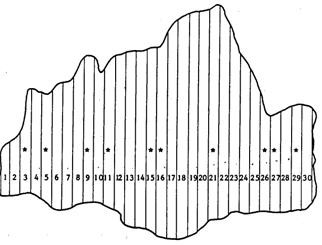Simple random sampling
(→Example 1:) |
|||
| Line 60: | Line 60: | ||
| − | ===Example 1:=== | + | ====Example 1:==== |
| Line 76: | Line 76: | ||
<blockquote> <math>var (\bar {y}) = \frac {N-n}{N-1} * \frac {\sigma^2}{n} = 0.491645</math> </blockquote> | <blockquote> <math>var (\bar {y}) = \frac {N-n}{N-1} * \frac {\sigma^2}{n} = 0.491645</math> </blockquote> | ||
| + | |||
| + | |||
| + | ::[[image:SkriptFig_73.jpg]] | ||
| + | ::'''Figure 73:''' Example population | ||
| + | |||
| + | ====Example 2:==== | ||
[[Category:Sampling design]] | [[Category:Sampling design]] | ||
Revision as of 17:51, 3 December 2010
Contents |
General observations
Simple random sampling (SRS) is the basic theoretical sampling technique. The sampling elements are selected as an independent random sample from the population. Each element of the population has the same probability of being selected. And, likewise, each combination of n sampling elements has the same probability of being eventually selected.
Every possible combination of sampling units from the population has an equal and independent chance of being in the sample.
Simple random sampling is introduced and dealt with here and in sampling textbooks mainly because it is a very instructive way to learn about sampling; many of the underlying concepts can excellently be explained with simple random sampling. However, it is hardly applied in forest inventories because there are various other sampling techniques which are more efficient, given the same sampling effort.
For information about how exactly sampling units are choosen see Random selection.
Notations used
Estimators Parametric Sample Mean \(\mu = \frac{\sum_{i=1}^N y_i}{N}\) <mat>\bar {y} = \frac{sum_{i=1}^n y_i}{n}</math> Variance \(\sigma^2 = \frac{\sum_{i=1}^N (y_i - \mu)^2}{N}\) \(s^2 = \frac{\sum_{i=1}^n (y_i - \bar {y})^2}{n-1}\) Standard deviation \(\sigma = \sqrt{\frac{\sum_{i=1}^N (y_i - \mu)^2}{N}}\) \(s = \sqrt{\frac{\sum_{i=1}^n (y_i - \bar {y})^2}{n-1}}\) Standard error (without replacement or from a finite population)
\(\sigma_{\bar {y}} = \sqrt{\frac{N-n}{N-1}}*\frac {\sigma}{\sqrt{n}}\) \(S_{\bar {y}} = \sqrt{\frac{N-n}{N}}*\frac{S_y}{\sqrt{n}}\) Standard error (with replacement or from an infinite population)
\(\sigma_{\bar {y}} = \frac{\sigma}{\sqrt{n}}\) \(S_{\bar {y}} = \frac{S_y}{\sqrt{n}}\)
- Where,
- \[N =\] number of sampling elements in the population (= population size);
- \[n =\] number of sampling elements in the sample (= sample size);
- \[y_i =\] observed value of i-th sampling element;
- \[\mu =\] parametric mean of the population;
- \[\bar {y} =\] estimated mean;
- \[\sigma =\] standard deviation in the population;
- \[S =\] estimated standard deviation in the population;
- \[\sigma^2 =\] parametric variance in the population;
- \[s^2 =\] estimated variance in the population;
- \[\sigma_{\bar {y}} =\] parametric standard error of the mean;
- \[s_{\bar {y}} =\] estimated standard error of the mean.
Examples
Example 1:
In this section, SRS estimators are illustrated with an example. This example will be pursued through the entire Lecture notes and illustrates that different sampling designs perform differently for the same population and with the same sample size. The example population has \(N = 30\) individual elements; we may imagine 30 strip plots that cover a forest area (Figure 73). This dataset will also be used in the further chapters for comparison among the performance of different sampling techniques. Table 11 lists the values of the 30 units. Here, for SRS, we are only interested in the y values. The \(x\) values are a measure for the size (area) of the strips; this will later be used in the context of other estimators. From this population we get the following parametric values:
\(\mu = \frac{\sum_{i=1}^N y_i}{N} = 7.0667\) and \(\sigma^2 = \frac{\sum_{i=1}^N (y_i - \mu)^2}{N} = 7.1289\)
If we take samples of size \(n=10\), then the parametric error variance of the estimated mean is:
\(var (\bar {y}) = \frac {N-n}{N-1} * \frac {\sigma^2}{n} = 0.491645\)
